
Back to Loco of the Month homepage
Back to Sidestreet Bannerworks
.
May 2006
Archangel Models' Rheidol 2-4-0T
by Marc Horovitz

The Vale of Rheidol Railway (VoR) is a 1' 11-1/2" line that runs between Aberystwyth and Devil's Bridge in Wales, a distance of over 11 miles. It was begun in 1901, intended to haul ore from the lead mines in the Rheidol Valley, as well as timber and passengers. It was the last steam line to be operated as part of the nationalized British Railways network. The line had a checkered history, passing through many hands. It became a private tourist line in 1989 and still runs today.
The prototype of the locomotive in question was originally built to 30" gauge for a foreign railway by Bagnall, and named Trezio de Mai. It was never delivered and was subsequently regauged a to 2'-3" for the Plynlimon & Hafan, who named it Tal-y-bont. When the P&H closed, the engine and a number of wagons were again regauged, this time to two feet. They were purchased by Pethicks, the contractors building the Vale of Rheidol. When the railway was completed, the 2-4-0 was kept, as it was the only engine that could work the harbor branch, the 2-6-2Ts being too heavy. It was named Rheidol and became the railway's No. 3. It was withdrawn from service in 1924. (Thanks to Sam Evans for this information.)
The model
This is one of Archangel's earlier models, and a popular one at that. It appeared in many variations over the years. It is a simple engine in some ways, but with a lot of sophisticated features.
The loco is alcohol fired, with the meths being carried in the large tank (the dummy coal bunker) behind the cab. It uses a chicken-feed system, with an odd control valve in the form of a screw in the rear buffer beam that can be opened with a screwdriver to allow meths to flow into the sump, then to the two-wick burner. The engine is internally fired, with a Smithies boiler. A superheater line passes between the inner boiler and outer shell to the engine's single cylinder between the frames. The two outside cylinders are dummies. Reversing is via a slip eccentric.
Backhead fittings include the usual throttle and blower valves, along with a pressure gauge and a whistle valve. The whistle is tucked up under the roof of the cab. Cylinder lubrication is provided by the displacement lubricator in the cab, suspended from the steam line. A large safety valve sits on the boiler ahead of the cab.
The side tanks on the engine are functional. They can be filled from either side, as there's a balance pipe between them. A hand pump resides in the left-hand tank. Since there's no water glass, the rule for filling the boiler is "little and often." When you become familiar with an engine's habits, you can usually tell when it's low on water. The actual inner boiler is pretty small, so one must pay attention to it. On my engine, the paint is flaking off the boiler, but is sound on the rest of the engine.
The run
This is another of those engines that I hadn't run in a very long time, so I had no idea whet to expect. t was a very lively engine the last time I had it out, so I expected a similar performance today.
I oiled it all round and filled the lubricator. I then filled the side tanks with distilled water in preparation for filling the boiler with the hand pump. It became immediately clear that that wasn't going to work. The balls in the pump had frozen and nothing was getting through. Given that, I filled the boiler through the safety-valve hole, then filled the large meths tank part way up, as I didn't want to run out of water first.
I popped the fan in the stack, turned it on, opened the meths valve to the burner, then lit the fire. So far, so good. Steam came up in a few minutes and I turned on the blower and removed the fan. The engine blew off at 60 pounds in that wonderfully flatulent way that's typical of Archangel engines. I opened the throttle, closed the blower, and gave the engine a push. In just a few feet, the cylinder was warm enough to take over on its own. As I had remembered, the engine was speedy, but I was able to throttle it down to a reasonable speed.
Unfortunately, for reasons unknown, the lead truck refused to hold the rails. I turned the engine around, to run in reverse, then coupled it to a train of four, four-wheel Archangel Vale of Rheidol coaches. With this to tame it a little, the engine became quite manageable and gave a fine run for around eight minutes, until it ran out of meths. It looked great with its train and produced quite an audible exhaust beat.
Stewart Browne's locomotives, as a rule, are unusual, nonconformist, and quirky, and this one is no exception. It's because of these qualities that they endear themselves to people. Rheidol is high on my list of favorites.
.
|
|
|
| Builder | Archangel Models (Stewart Browne) |
| Date built | July 1977 |
| Gauge | 0 (32mm) |
| Scale | 16mm |
| Boiler | Internally fired, Smithies |
| Fittings | Safety valve, throttle, blower, whistle, pressure gauge, clack valve from hand pump |
| Fuel | Alcohol |
| Blow-off pressure | 60 psi |
| Cylinders | One, double-acting D-valve |
| Reversing gear | Slip eccentric |
| Lubricator | Displacement |
| Weight | 5 lb., 6 oz. |
| Dimensions | Length over end beams, 11"; width, 4"; height, 5-5/8" |
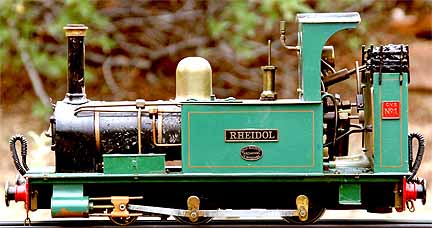

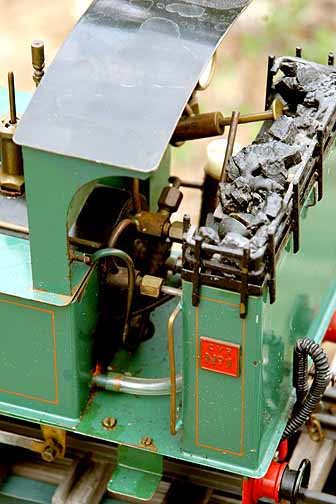
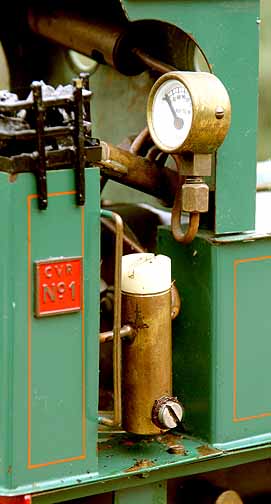
The cab is crowded and confusing. In the upper right is the whistle valve. Sticking up, across it, is the throttle lever. Just visible below is the blower-valve spindle. The plastic tube on the floor is the balance pipe between the side tanks.
.
The pressure gauge actually hangs half out of the right side of the cab. The displacement lubricator is suspended from the steam line. The whistle can just be seen above.
.


Left: The dummy coal load comes off to reveal a screw plug, the filler for the meths tank. The black paint atop the tank helps to disguise it when the coal load is in place.
Above: Fuel is controlled by this spring-loaded screw on the rear beam, an odd arrangement.




One of the engine's many endearing characteristics is this rather crudely made shovel, clipped to the running board on the left side. A toolbox used to adorn the front beam, but it has been lost in the mists of time.
.
The paint is peeling badly on the boiler, a problem with some Archangel locomotives. Paint on the rest of the engine is in pretty good shape for its age.

Underneath. The single cylinder, at the right end, powers the leading drive axle. The lead truck is between the cylinder and the axle. the two-wick burner fires the Smithies boiler. Altogether, an unusual locomotive.
.
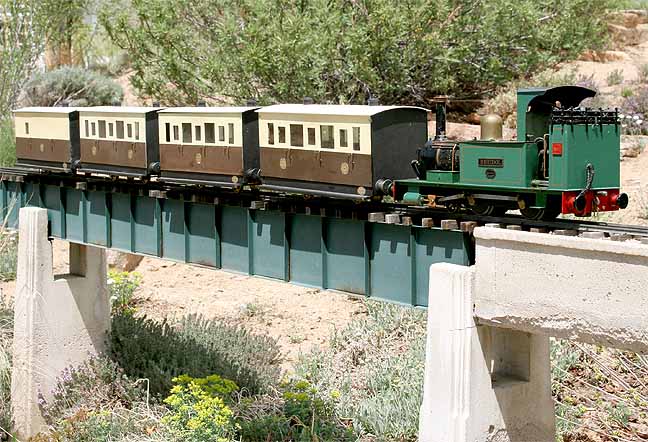
Right: Coming through the springtime vegetation. The needle on the pressure gauge can just be seen, reading about 40 psi.
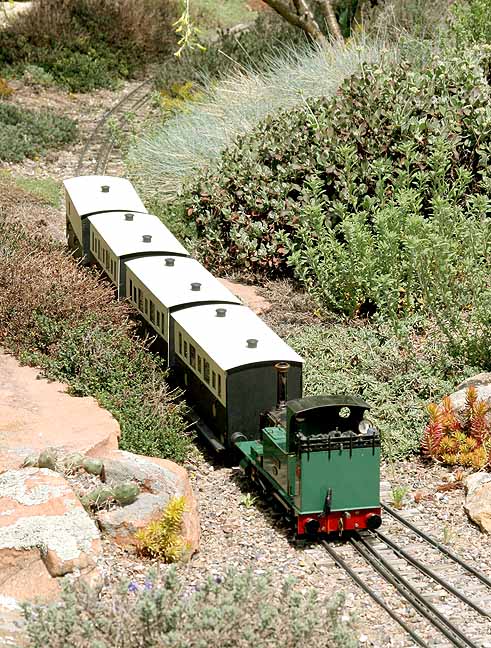
Back to Loco of the Month home page
Back to Sidestreet Bannerworks home page
This page and its contents
Copyright Sidestreet Bannerworks, 2006
.